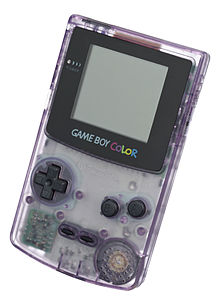Nintendo Game Boy Color
 |
|

Atomic Purple version of the Game Boy Color.
|
|
| Manufacturer | Nintendo |
|---|---|
| Product family | Game Boy line |
| Type | Handheld game console |
| Generation | Fifth generation |
| Release date | |
| Retail availability | 1998–2003 |
| Discontinued | May 30, 2003 |
| Units sold | Worldwide: 118.69 million, including Game Boy units |
| Media | ROM cartridge |
| CPU | Sharp LR35902 core @ 4.19/8.38 MHz |
| Display | LCD 160 x 144 pixels, 44x40 mm |
| Online services | Mobile System GB |
| Best-selling game | Pokémon Gold and Silver, approximately 14.51 million combined (in Japan and the USA) (details). |
| Backward compatibility |
Game Boy |
| Predecessor | Game Boy |
| Successor | Game Boy Advance |
The Game Boy Color (ゲームボーイカラー? Gēmu Bōi Karā), referred to as GBC, is a handheld game console manufactured by Nintendo, which was released on October 21, 1998 in Japan and was released in November of the same year in international markets. It is the successor of the Game Boy.
The Game Boy Color, as suggested by the name, features a color screen, but no backlight. It is slightly thicker and taller than the Game Boy Pocket, which is a redesigned Game Boy released in 1996. As with the original Game Boy, it has a custom 8-bit processor somewhat related to a Zilog Z80 central processing unit (CPU). The original name - with its American English spelling of "color" - remained unchanged even in markets where "colour" was the accepted English spelling.
The Game Boy Color's primary competitors were the much more advanced Neo Geo Pocket by SNK and the WonderSwan by Bandai (both released in Japan only), though the Game Boy Color outsold these by a wide margin. The Game Boy and Game Boy Color combined have sold 118.69 million units worldwide. It was discontinued in 2003, shortly after the release of the Game Boy Advance SP.
The Game Boy Color was a response to pressure from game developers for a more sophisticated handheld platform, as they felt that the Game Boy, even in its latest incarnation, the Game Boy Pocket, was insufficient. The resultant product was backward compatible, a first for a handheld system, and leveraged the large library of games and installed base of the predecessor system. This became a major feature of the Game Boy line, since it allowed each new launch to begin with a significantly larger library than any of its competitors.
...
Wikipedia
